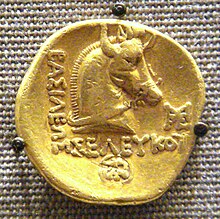
Back بوسيفالوس Arabic Busefal Azerbaijani Буцефал Bulgarian বুসেফেলাস Bengali/Bangla Bucèfal Catalan Bukefalos Czech Буцефал CV Bukephalos Danish Bukephalos German Βουκεφάλας Greek
 Coin depicting Bucephalas, issued by Seleucus I Nicator. Note the horns on his head, from a literal interpretation of his name, which means "ox-head(ed)". | |
| Species | Horse |
|---|---|
| Sex | Male |
| Born | c. 355 BC |
| Died | June 326 BC (aged 30) Pentapotamia, Macedonian Empire (modern-day Pakistan) |
| Resting place | Bucephala |
| Occupation | Warhorse |
| Years active | 344 BC – 326 BC |
| Owner | Alexander III of Macedon |
Bucephalus (/bjuː.ˈsɛ.fə.ləs/; Ancient Greek: Βουκεφᾰ́λᾱς, romanized: Būcephắlās; c. 355 BC – June 326 BC) or Bucephalas, was the horse of Alexander the Great, and one of the most famous horses of classical antiquity.[1] According to the Alexander Romance (1.15), the name "Bucephalus" literally means "ox-headed" (from βοῦς and κεφᾰλή), and supposedly comes from a brand (or scar) on the thigh of the horse that looked like an ox's head.[2]
Ancient historical accounts[3] state that Bucephalus's breed was that of the "best Thessalian strain", and that he died in what is now Punjab, Pakistan, after the Battle of the Hydaspes in 326 BC. Alexander was so grieved at the loss of his horse that he named one of the many cities he founded after him, as Alexandria Bucephalus.
- ^ Wasson, Donald (6 October 2011). "The Bucephalus". World History Encyclopedia.
- ^ Kouymjian, Dickran (2012). "Did Byzantine Iconography Influence the Large Cycle of the Life of Alexander the Great in Armenian Manuscripts?". Byzantium and Renaissances. Dialogue of Cultures, Heritage of Antiquity, Tradition and Modernity. University of Warsaw Press. pp. 209–216.
- ^ The primary (actually secondary) accounts are two: Plutarch's Life of Alexander, 6, and Arrian's Anabasis Alexandri V.19.
© MMXXIII Rich X Search. We shall prevail. All rights reserved. Rich X Search